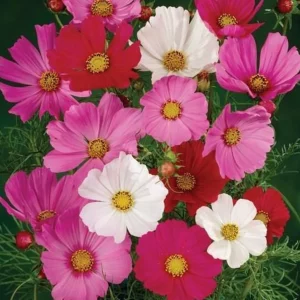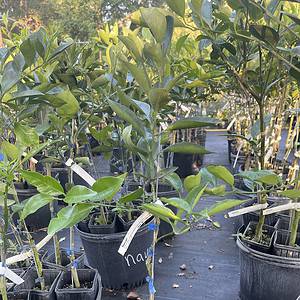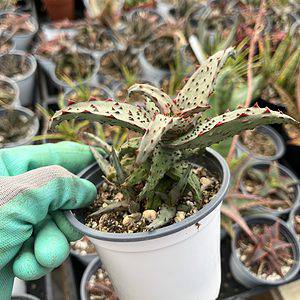No products in the cart.
Table of Contents
Do you have a warm-temperature garden? Then, the Curcuma plants will thrive in your landscape. This elegant summer blooming flower looks great in container gardens.
The Curcuma genus includes plants that will add a tropical feel to your garden. The plant’s lengthy stems with slightly hidden flowers look like pinecones giving it the name hidden cone gingers.
More About This Tropical Plant
The clustered flowers of Curcuma plants are vibrant from summer to fall but it’s during the spring season when they are most remarkable. The plant is underdeveloped in this period. It is like a potluck when buying them as you never know what to expect.
When planted with daffodils, a flowering bulb, the turmeric plant provides you with a hue from spring to autumn.
Its origin can be found in Southeast Asia, Southern China, New Guinea, and Northern Australia. On the other hand, you find some species growing in tropical Africa and Central America.
Many botanists believe that the Curcuma longa is native to India and is used in medicine and food. Many gardeners grow them as northern perennials.
When growing Curcuma in its native habitat; it starts emerging in the monsoon season. While dry weather makes them dormant and cultivated for thousands of years, turmeric plants are the healthiest foliage, and people dry the rhizomes for spice or use it as a yellow dye.
In contrast, the Curcuma amada rhizome is what you can eat fresh for fighting inflammation. Some people consume the rhizomes of the Curcuma zedoaria as a bitter vegetable. Alternatively, you can grow Curcuma for cut flowers as they are winter hardy.
Curcuma Plant Care

Before we get to the meticulous care of the Curcuma, here is a short list of everything you need to grow these attractive flowers.

Best Potting Medium for Your Plant
Whether you have a hidden lily or a turmeric plant, the care needs are basically the same. The plant does well in moist, well-drained soil such as coarse sand filled with organic matter. However, it does not flourish in the clay ground.
So, now you have a good reason to start a home compost filling it up with food scraps and garden waste. Just remember not to add meat. You can grow them in container gardens, garden beds, or a pot standing in a sunny window.
Ideal Lighting for Curcuma
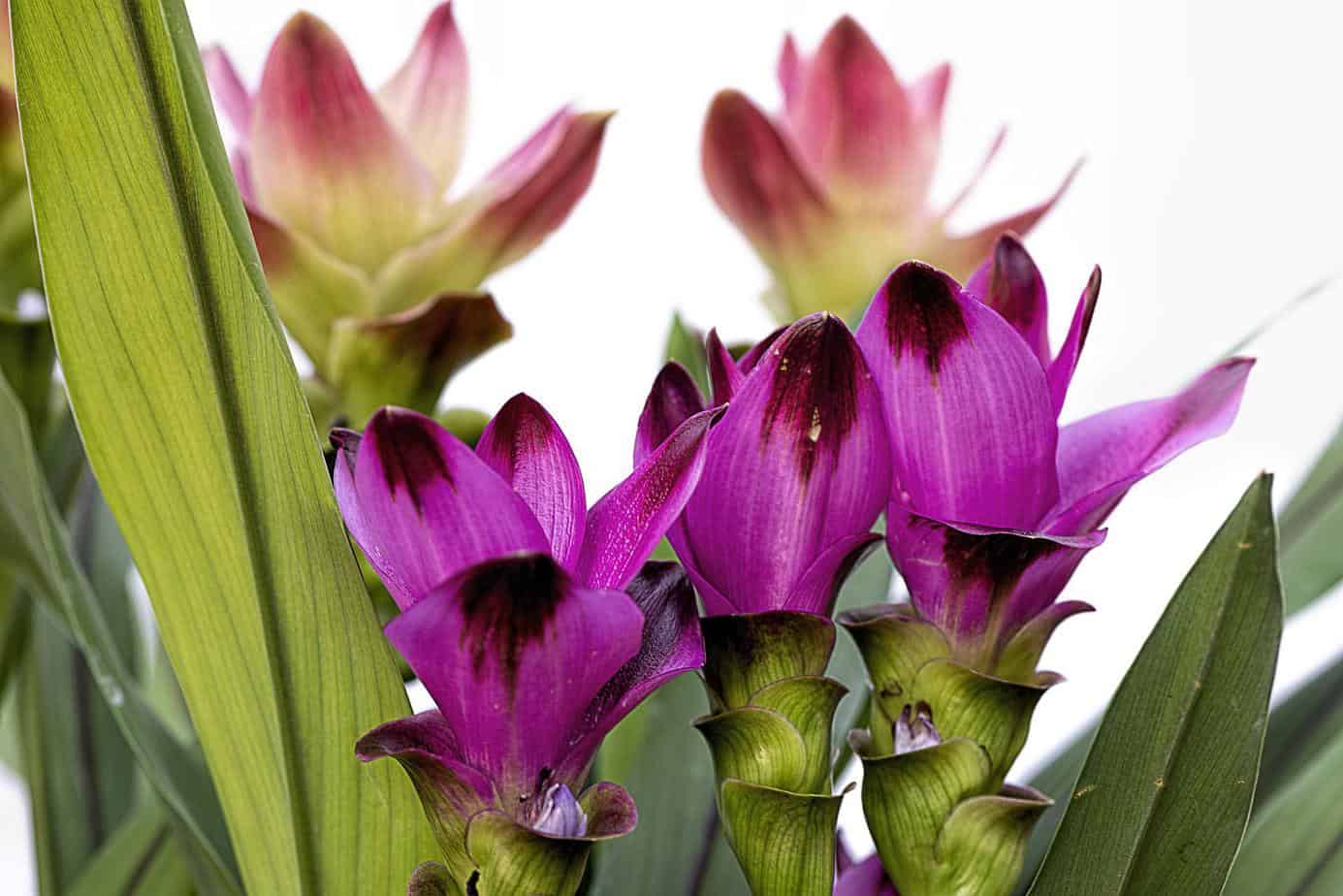
While you can place your plant in full sun, it thrives better in partial sun. When exposed to more than two hours of sun per day, the plant’s foliage may begin to burn.
You can place the foliage in an open shade, but the blooms will not be so vibrant with the lack of sunlight. Thus, provide your outdoor plants with some morning sunshine and afternoon shade. Or, grow them in a partly shaded spot.
Watering Needs for Your Plants
The Curcuma loves constant moist soil and can withstand heavy rainfalls if the ground is free-draining. Never let the potting mix dry, or else, it will lose its green foliage.
You can water them well once a week from spring to summer. If there’s scorching weather, check the soil’s moisture level from time to time. If you find the top few inches dry, you need not water but if it dries out more, then quench its thirst with watering.
As an outdoor plant, you can add mulch to help retain moisture and layered about two inches deep. In addition, you can reduce your watering schedule in fall and winter as it becomes a dormant plant.
On the other hand, if you grow Curcuma as an indoor plant, make sure that it has well-drained soil. Take note that pots can dry fast, so it’s best to keep an eye on the moisture as it will need more watering in the growing season.
Temperature & Humidity
Curcuma plants also need warm temperatures. The ideal temperature is between 68°-95° F (20°-35°C). When exposed to sunshine for up to three hours, the turmeric beauty grows gorgeous flowers but not too much sun.
When it comes to humidity, the ideal moisture level should not drop below 60%. You can give your Curcuma just a small splash of water.
Fertilizer During Flowering Season
Your perennial will bloom when you feed them a soluble fertilizer like 20-20-20. You can apply a tablespoon of feed per square foot where your plants grow.
Provide your Curcuma with fertilizing in spring when new growth appears. Adding some manure or compost also helps to provide the nutrients it needs.
Propagation of Curcuma

The fantastic news is you can grow your Curcuma species in pots. Opt in choosing a 12-inch tall to 18-inch wide container. Fill the pot with the ground and get two rhizomes from the store to break into small pieces.
You can place the tubers two inches below the soil surface with the bud tips facing up. Water regularly for healthy growth.
Curcuma seeds are primarily sterile and they are even difficult to find. But if you are lucky to have wild species, you need to hand pollinate them in summer. If you manage to get seeds, germinating them is easy. In late fall, you collect the seed from the seed pods and surface sowed without covering immediately.
Growth Zone

Curcuma planted in the USDA zones 8 to 11 are winter hardy. But it helps to provide them with morning sun and some afternoon shade.
Potting and Pruning
Before the winter arrives or in early spring after the last frost passes, you can sow your Curcuma in the ground. While they grow in spring, the best benefits you reap will be in summer, so do not rush it. After the frost passes and the weather remains cold, wait before planting them.
Whether you decide to develop them in your garden or a pot, the crucial thing is drainage with some gravel layered at the base. You can place the rhizomes about three inches deep, and for planting in the landscape, leave about a foot between each Curcuma.
As summer arrives, your plants greet you with bunched flowers that are mildly fragrant for about four weeks. You will see that the foliage is dense, and the green foliage appears with lance-shaped leaves.
After flowering, grab your sterilized pruners and cut the flower spike down to four inches above the ground. You need not trim your Curcuma during the growing season but can remove the brown leaves.
-
Free Shipping$39.97Sold By: Grow Your Own Food Nursery
In stock
River Tamarind Miracle Tree Plant
Sold By: Grow Your Own Food Nursery -
Free Shipping$7.99 – $14.29Sold By: CZ Grain
In stock
Cosmos Flower Seeds, Sensation Mix Color Seeds – Non-GMO Seeds – Ships from Iowa, USA
Rated 4.60 out of 5 based on 156 customer ratings00Sold By: CZ Grain -
$70.00Sold By: Andy Nursery
$75.00In stock
Navel Orange Grafted Citrus Tree. 3 Feet Tall. Free Shipping
Sold By: Andy Nursery -
$26.99Sold By: Cacti and Exotica
In stock
4″ Aloe castilloniae
Rated 4.98 out of 5 based on 59 customer ratings00Sold By: Cacti and Exotica
Curcuma Winter Protection
As the vegetation is perennial, it does go dormant in cold weather. To protect Curcuma, you can cut them down as it will keep them protected growing outside.
Still, if you grow their containers, you can bring them inside if the temperature drops below freezing point.
Curcuma Varieties
Curcuma longa

The spice turmeric foliage grows up to three inches with pinecone-shaped flowers. The exciting thing is the blooms nestles inside the leaves.
Curcuma petiolata
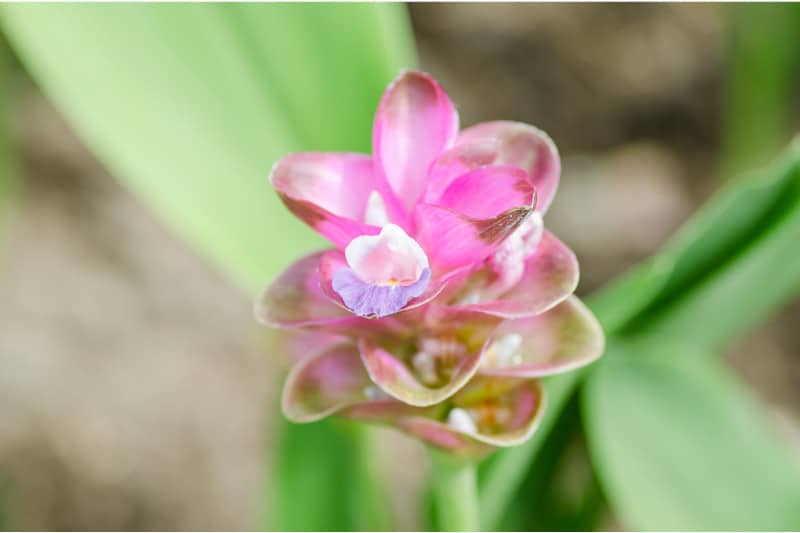
The hidden cone ginger also produces huge leaves growing ten inches in length with a six-inch width. The leaves sprout from the rhizome growing in a clump form with purple flowers in late summer.
Curcuma zedoaria
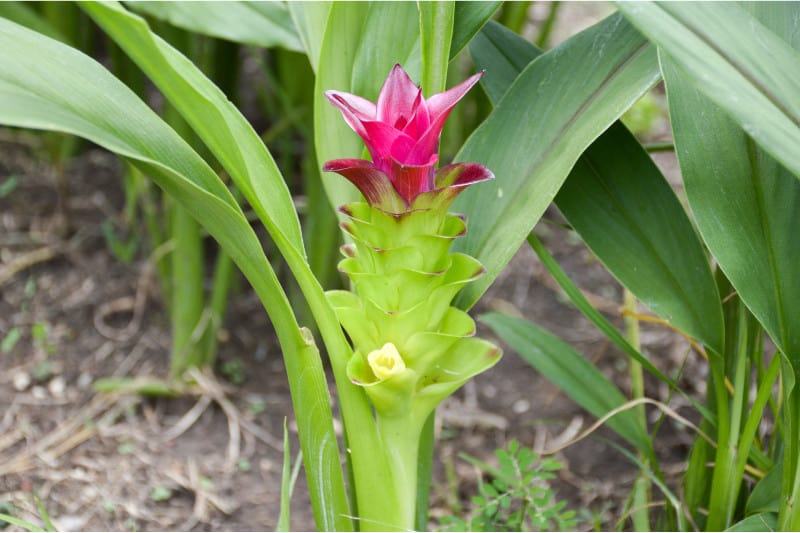
Here we have bicolor hidden cone ginger with bicolor bracks in white with beautiful purple tips. The foliage grows up to six feet, with maroon stripes running down the center.
Curcuma Diseases & Pests
Curcuma pests that can be of major concern are the shoot borer and scale causing an infestation in your plants.
The shoot borer lies eggs on the leaves with an oval pink shape that can hatch in six days. Once the larvae bore hatches, they start feeding on the internal tissues of the pseudostems. You will notice a hole, and the leaves start to yellow and dry.
On the other hand, a scale is a tiny insect with brown to gray colors living on the rhizomes. These critters feed on the buds, and the flowers die and are noticeable during summer.
Frequently Asked Questions
It helps provide your Curcuma with organically rich, well-draining, slightly acidic soil. Your plants also need a few hours of the sun, while some Curcuma species do well in open shade.
When the Curcuma blooms, it has a slight fragrance and can last up to four weeks before you start noticing faded flowers.
Depending on your Curcuma species, they can grow from two to seven feet tall.
Yes, Curcuma, also known as turmeric, is a perennial plant, meaning it comes back every year. It goes dormant during the colder months and regrows from its rhizomes when the conditions become favorable again in the following growing season.
Cut back the foliage after the first frost and carefully dig up the rhizomes. Remove excess soil and store the rhizomes in a dry, cool place. Replant them in spring after the last frost when the temperature warms up to ensure they come back next year.
Whether you want to buy, sell, or simply reach out to other plant enthusiasts, Plantly is the right place to be!
In stock In stock In stock In stock
Free Shipping
$39.97
Sold By:
Grow Your Own Food Nursery
River Tamarind Miracle Tree Plant
Sold By:
Grow Your Own Food Nursery
Free Shipping
$7.99 – $14.29
Sold By:
CZ Grain
Cosmos Flower Seeds, Sensation Mix Color Seeds – Non-GMO Seeds – Ships from Iowa, USA
Rated 4.60 out of 5 based on 156 customer ratings00
Sold By:
CZ Grain
$70.00
Sold By:
Andy Nursery
$75.00Navel Orange Grafted Citrus Tree. 3 Feet Tall. Free Shipping
Sold By:
Andy Nursery
$26.99
Sold By:
Cacti and Exotica
4″ Aloe castilloniae
Rated 4.98 out of 5 based on 59 customer ratings00
Sold By:
Cacti and Exotica

